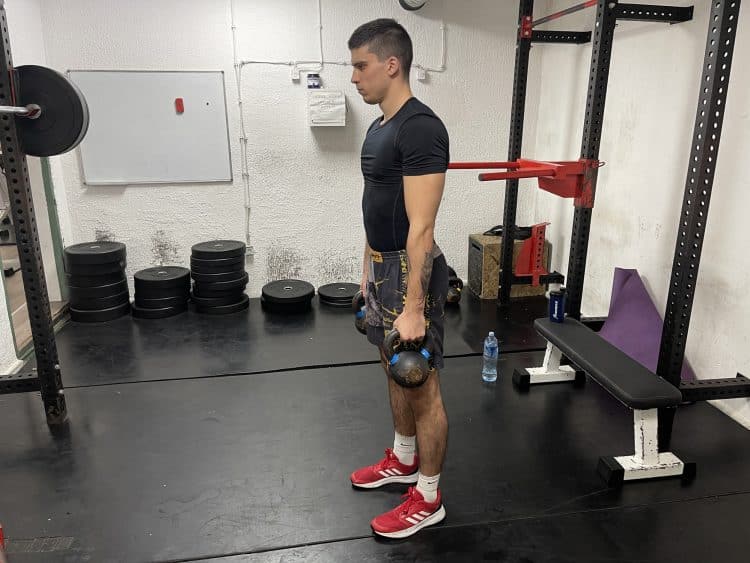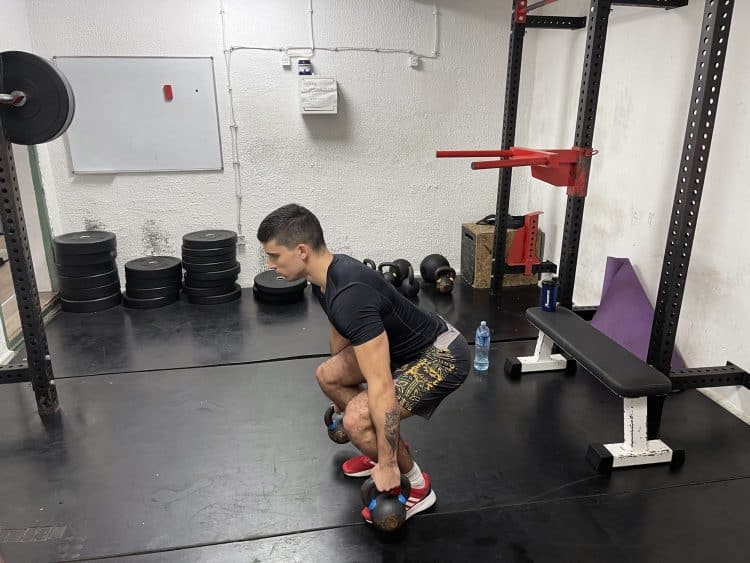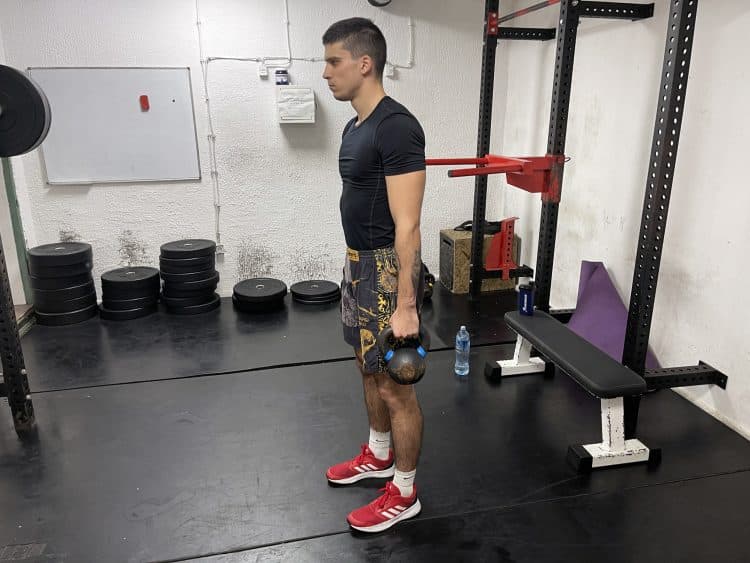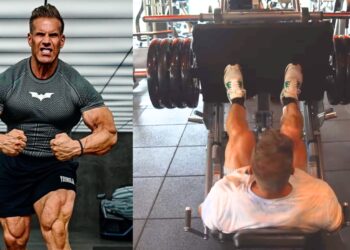Are you experiencing low back pain while doing barbell back squats and are unsure if you should perform squats at all?
Here is something interesting to consider.
A study titled “Altered squat movement pattern in patients with chronic low back pain” found that individuals with lower back pain (LBP) use their hip and knee joints more extensively than those without LBP during maximal squats. (1)
During a barbell back squat, the bar puts substantial pressure on your lumbar spine and forces you to move more from hips and knees than ankles when doing squats.
This is why incorporating suitcase squat variation in your workout is essential. Suitcase squats put less stress on your lower back because of its setup. In addition, they are also excellent for strengthening your core and improving your overall grip strength.
In this article, you’ll learn how to perform suitcase squats correctly, the muscles worked, its benefits, and the most notable alternatives.
Level Up Your Fitness: Join our 💪 strong community in Fitness Volt Newsletter. Get daily inspiration, expert-backed workouts, nutrition tips, the latest in strength sports, and the support you need to reach your goals. Subscribe for free!
How To Do a Suitcase Squat: Step-By-Step Guide
Below is a step-by-step guide on how to perform suitcase squats correctly:
Step One — Get Into the Starting Position
Stand upright while holding a kettlebell or dumbbell in each hand. Assume a hip-width stance, keep your knees extended and back flat, and look straight ahead.
Pro Tip: If you lack ankle mobility, turn your toes outwards to achieve a deeper squat.
Step Two — Initiate the Eccentric Phase
Slowly lower yourself into the bottom squat position by bending at your hips, knees, and ankles. When you achieve maximal depth, hold that position for one second. Ensure your back is neutral and core tight throughout the whole movement.
Pro Tip: Use three-second eccentric phases to increase muscle stress and bias hypertrophy.
Step Three — Initiate the Concentric Phase
Extend your ankles, knees, and hips to return to the starting position. Ensure your back is flat and your core is activated throughout the concentric phase. Your hips and knees will be fully extended at the top of the range of motion.
Pro Tip: To build more explosive strength and power while ensuring you don’t butcher the form and technique, rip through the concentrics.
Muscles Worked During Suitcase Squats
The primary muscles include:
- Quadriceps
- Gluteus maximus
- Adductors
The secondary muscles are:
- Core musculature
- Hamstrings
- Forearm flexors
- Erector spinae
Benefits of Suitcase Squats
These are the pros of adding suitcase squats to your exercise arsenal:
Beginner-Friendly
Suitcase squats are a beginner-friendly exercise as the weight is not placed on your back, substantially reducing injury risk.
Secondly, you can’t go as heavy on them as barbell squats, further reducing injury risk. Finally, they are easy to teach, making it perfect for beginners to learn the squat mechanics.
Rehabilitation Applications
The number one reason suitcase squats are one of the best squat variations to implement during rehabilitation is because they place less strain on your back. Nonetheless, you must consult your healthcare provider before starting a new training routine.
Suitcase squats strengthen your core muscles, which is usually one of the primary goals of every rehabilitation program. A strong core plays a major role in preventing different lifting and sports-related injuries.
Lower Body Strength
Suitcase squats can help build lower body strength and muscle mass, especially for beginners. This is why you can find suitcase squats in most beginner weightlifting programs.
Balance and Core Stability
Suitcase squats are especially effective at increasing your core strength and overall balance as they force your internal and external obliques, transversus abdominis, and rectus abdominis to stabilize the movement. Depending on the weights in your hands, different muscles will fire up.
Suitcase Squat Variations and Alternatives
Below are the best suitcase squat variations and alternatives:
Dumbbell Step-Up
Dumbbell step-up is an intermediate unilateral exercise. It is widely used in sports such as volleyball, basketball, and handball to build core strength, stability, and balance.
Level Up Your Fitness: Join our 💪 strong community in Fitness Volt Newsletter. Get daily inspiration, expert-backed workouts, nutrition tips, the latest in strength sports, and the support you need to reach your goals. Subscribe for free!
Steps:
- Stand in front of an 18-inch plyo box with a dumbbell in each hand.
- Position your feet hip-width apart, knees extended, back straight, and your eyes locked straight ahead.
- Start the exercise by stepping on the plyo box with your right foot.
- Stand on top of the box with both your feet placed next to each other.
- Reverse the motion to return to the starting position
- Repeat on the same side for recommended reps.
- Switch legs after completing the desired number of reps.
Pro Tip: If you want to work your posterior chain more, lean forward during the exercise to stretch those glutes and hamstrings.
Kettlebell Lunge
Kettlebell lunges are among the most challenging unilateral exercises because of how much your adductors are activated during the movement. Your adductor acts as dynamic stabilizers during lunges and will tire quickly because they weren’t built for repetitive endurance-based activities.
Steps:
- Stand erect with a hip-width stance and a kettlebell in each hand extended at your sides.
- Your knees should be extended, your back flat, and your eyes should be fixed on the wall in front of you, meaning you must keep your neck neutral throughout the exercise.
- Start the exercise by lunging forward with your right leg.
- Lower yourself until your left knee almost touches the ground.
- Extend your knees and hips and bring your left foot beside the right.
- Alternate between legs for the recommended reps.
Pro Tip: Feel free to let your knees extend beyond your toes if you are an athlete. Such a thing is desirable since you will never have a real-life or game situation where you can limit ankle dorsiflexion.
Bodyweight Glute Bridge
Glute bridges are considered a regression exercise to suitcase squats because they require less stability and external resistance to overcome.
You can perform glute bridges for quite some time before transitioning to suitcase squats. This approach is particularly beneficial for seniors or those who have been inactive for some time and must first reestablish their foundational strength levels.
Steps:
- Lay on the floor on your back.
- Bend your knees and hips so your heels are next to your glutes.
- Place your hands on the sides for added support.
- Start the exercise by pushing your hips towards the ceiling while maintaining contact with the floor with your upper back, head, arms, and feet.
- Pause at the isometric contraction point at the top for one second.
- Reverse the motion by lowering the hips to the floor.
- Don’t rest your hips on the floor at the bottom of the ROM.
Pro Tip: Squeeze your glutes at the top as hard as possible for maximal muscle fiber activation.
Box Squats
Box squats are a back squat variation. They are excellent for building explosive strength and power.
Steps:
- Place a plyo box, slightly taller than your knee height, behind you.
- Stand with a shoulder-wide stance in front of the box with a barbell across your shoulders. Turn your toes outward slightly.
- Slowly lower yourself toward the box by simultaneously bending your ankles, knees, and hips.
- Keep your back flat the entire time.
- After your bum touches the box, quickly reverse the motion by extending your ankles, knees, and hips to return to the starting position.
- Repeat for the desired reps.
Pro Tip: Contract all your muscles on concentrics to build more explosive strength.
Barbell Back Squat
Barbell back squats are one of the most advanced lifts, requiring perfect form and execution to maximize rewards and limit injury risk. (2)
Steps:
- Stand with your feet shoulder-width apart and your toes turned slightly outwards, with a barbell on your shoulders.
- Make sure to keep your back neutral throughout the ROM.
- Lower towards the floor by flexing your knees, hips, and ankles until you enter a deep squat position.
- Reverse the movement to push the barbell back to the standing starting position.
- Repeat for the desired number of reps.
Pro Tip: Focus on maintaining proper form by taking a deep breath into your abdomen (not just your chest), and brace your core as if you’re about to be punched in the stomach.
FAQs
What makes suitcase squats different from regular squats?
The primary factors differentiating suitcase squats from regular squats are the amount of pressure put on your spine and the amount of core, more precisely oblique, activation required.
In addition, suitcase squats also require more grip strength. I would like to add that you can’t go as heavy on the suitcase squats as barbell back or front squats.
Can suitcase squats improve my balance?
Definitely, suitcase squats are one of the best squat variations for improving your balance, especially in the frontal and transverse planes. This is because the weight in your hands will shift in all directions, causing your center of mass to change.
This then forces your obliques and other additional core muscles to stabilize the movement, resulting in improved balance.
Are suitcase squats good for building muscle or losing weight?
Suitcase squats are decent for building muscles and losing weight. However, to build more muscle, you’ll eventually need to use heavier weights beyond what suitcase squats can accommodate due to the limiting factor of grip strength. This makes it challenging to perform very heavy suitcase squat reps.
Besides exercise, you must also adjust your dieting and recovery program to lose weight. Remember, the only way to lose weight is to be in a caloric deficit, which is achieved by consuming less than your total daily energy expenditure (TDEE) value.
How often should I incorporate suitcase squats into my workout routine?
For large muscle groups such as your quads, hams, and glutes, it is generally recommended to rest between 48 and 72 hours before exercising the same muscles again. However, since you are unlikely to load your suitcase squats to the point of exhaustion, you can do them more often. In the end, it all depends on how fast you are able to recover.
What are some common mistakes to avoid when doing suitcase squats?
While I have seen different mistakes in the past, I would say that leaning to one side and not engaging your core enough are the biggest ones. Caving your knees inward is also something you should avoid at all costs.
Wrapping Up
Suitcase squats are one of the most beginner-friendly squat variations you can try without worrying too much about injuring yourself. They are extremely effective at challenging your core and grip strength, which is beneficial for all those just starting their lifting or rehabilitation program.
Suitcase squats put less stress on your lumbar spine, making them a great option for those who still want to squat but can’t because of the strain on their lower back while doing the barbell back squats. In the comments below, let me know your thoughts on the suitcase squat variation and how you implement it in your workout routine.
References
- Zawadka M, Smołka J, Skublewska-Paszkowska M, et al. Altered squat movement pattern in patients with chronic low back pain. Ann Agric Environ Med. 2021;28(1):158-162. doi:10.26444/aaem/117708
- Knopfli C, Achermann B, Oberhofer K, Lorenzetti SR. First Insights in the Relationship between Lower Limb Anatomy and Back Squat Performance in Resistance-Trained Males and Females. Bioengineering. 2023; 10(7):865. https://doi.org/10.3390/bioengineering10070865
Relevant Articles:
Article Updates Timeline:
Our editorial team experts constantly update the articles with new information & research, ensuring you always have access to the latest and most reliable information.
February 6, 2024
Written By
Vanja Vukas
Edited By
Vidur Saini
Reviewed By
Editorial Team
Interested in measuring your progress? Check out our strength standards for Box Squat, Deadlift, Squat, and more.











